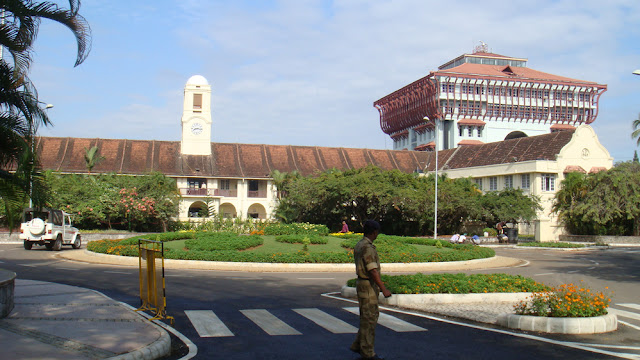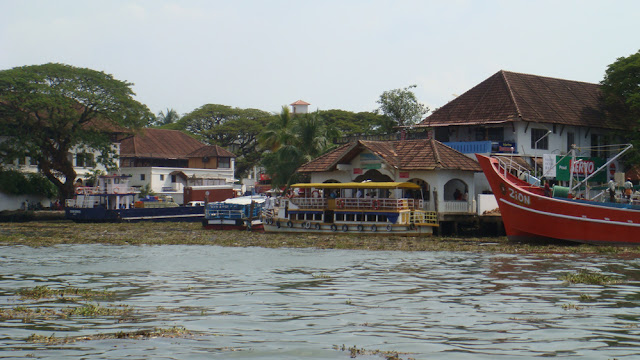 |
| A view of the readymade garments market at Janpath |
Place:
DELHI
Janpath is one of the most well known roads in Delhi. Once a busy commercial area, Janpath in central Delhi is one of the radial roads emerging from Connaught Place.
Janpath is still home to a lot of offices, though as the focus of the city has moved out of Connaught Place, Janpath too has suffered in the sense of no longer being seen as 'trendy'. It has lost out as new malls and a spread of the city have opened new hangouts for the city's young.
This north south heavily tree lined road was once called Queensway, and lets start our journey from the north end of this road.
The readymade clothes
market to the west of the road is easily the most popular part of the road, which opened in 1931 as a new capital of India was inaugurated by the British. It has come up rather haphazardly, as a result is dependent on the shape of the major buildings - LIC Building, then Indian Oil Bhavan and Scindhia House on the other side.
The market offers great opportunity for the budget shopper, so it no surprise that college students are amongst its biggest patrons. Trendy knock offs of the latest fashion are readily available, though again the market's heydeys were in the years before mid range retail came into India. Jeans, trousers, capris, shirts, skirts, ethnic dresses, shorts, minis, scarves, fake pashmina shawls .... Just remember,
bargain. Prices are usually 50 to 80% higher than the actual price! Add to this junk jewellery - lots of it, glass vases, curios, lamps, pens, mirrors, colour painitings, crafts, even an odd second hand book store, and this is a great place for visitors who have to take curios. Interesting stores include Handpaper and Tantra.
An extension is the Tibetan market, immediately after the crossing also the west, which has more curios, from tangkhas to block print stubs to brass lamps. The tone of the stores is far more momento-ish, and are more closed. Don't expect too much Tibetan stuff though.
But Janpath does not end at the flea market. The road also has fancier retail including Tribhuvandas Bhimji Zaveri (jewellery), Ferrari etc. Possibly the best retail destination is Central Cottage Industries Emporium, better known as
Cottage, which is close to the main market, across the first crossing on the east. Check it out for ceramics, silver and brass ware, textiles, crafts, folk art, etc. A must for summers, when temperatures outside at midday can touch 45C.
This is followed by a few office blocks. There are many important offices on this road, including headquarters for telecom companies MTNL and BSNL, Western Court, State Trading Corporation (STC).
Across the road, hidden from view by the Tibetan Market, is the
Imperial, the oldest five star hotel in the city and one of its best. Do check it out even if you do not stay here - at over $200 a night, it can be out of reach for many. Soon after it is the state run and much less venerable Janpath hotel.
The first roundabout is ringed by two major hotels. The
Meridien, part of Starwood, is known for chic design and Panju shaadis. The
Shangri-la, not a patch on the other hotels the brand has globally, nevertheless has a few bright spots including its oriental restaurant.
Continuing down the road to the west is the
National Archives, not easily accessible. Across the road is the Indira Gandhi National Centre for Arts (IGNCA), which has some great exhibitions. Janpath here crosses Rajpath, once Kingsway and still amongst Delhi's showcase roads. Take a moment to look towards India Gate on way and the Rashtrapati Bhawan the other way. Cameras to the duty, please.
Delhi's top museum,
National Museum is further this road to the east. While it cannot compare with its famed counterparts from around the world, it still offers an introduction to Indian history. It also has a museum shop, but is of stock of almost whatever you ask for. If the Gandhara Buddha bust or replicas of Indus Valley seals are available, get extras. The new office of the external affairs ministry has opened across the road.
The south end of the road is home to some politicians, all behind high fences. There are many eateries and coffee shops along the way, along with every hotel having its F&B outlets. Try Fresc Co for Italian, Saravana Bhavan for south Indian, or if in the mood to spend the Spice Route or 1911 at Imperial.
In winter, a walk down the road is good idea to get an idea of Delhi of yore.
















